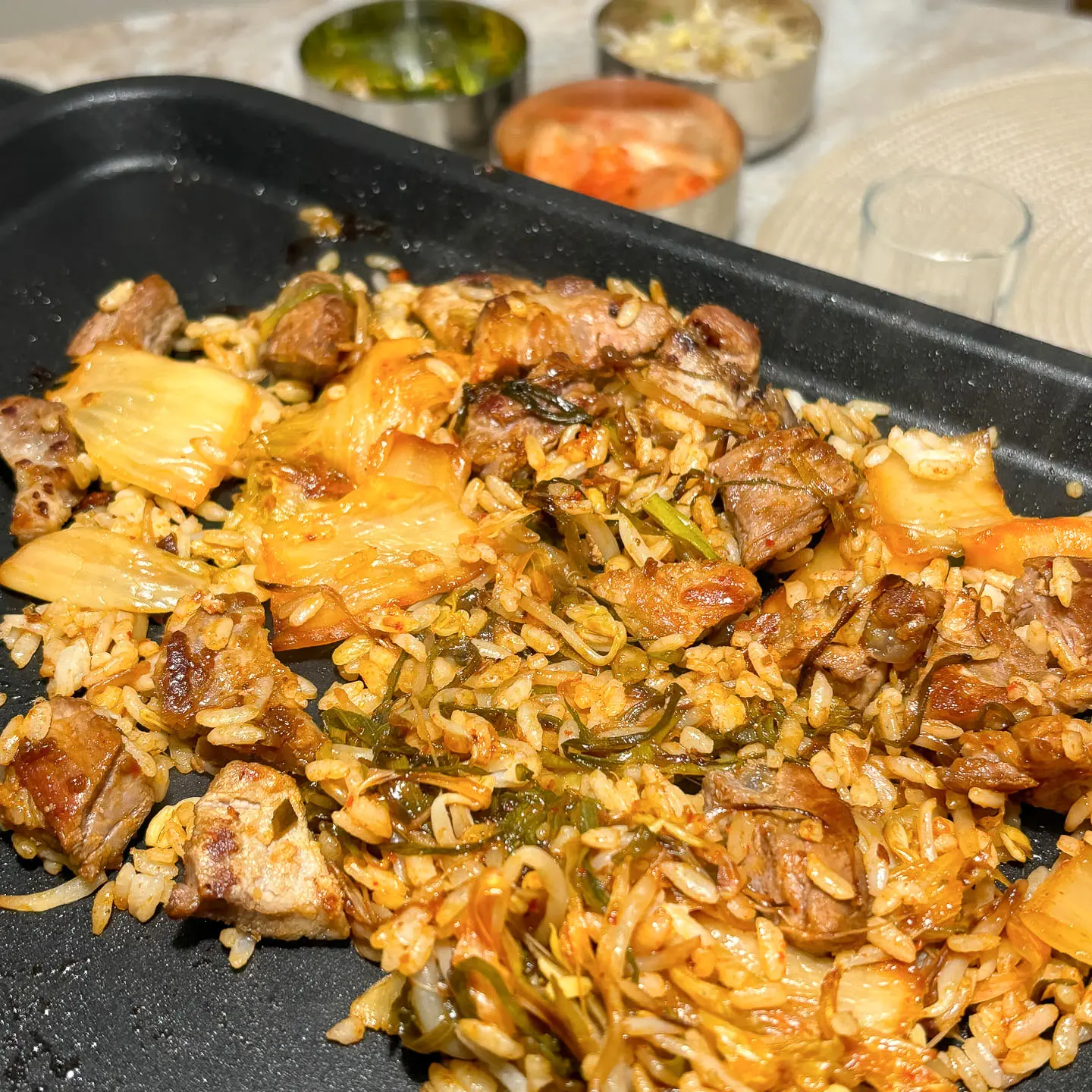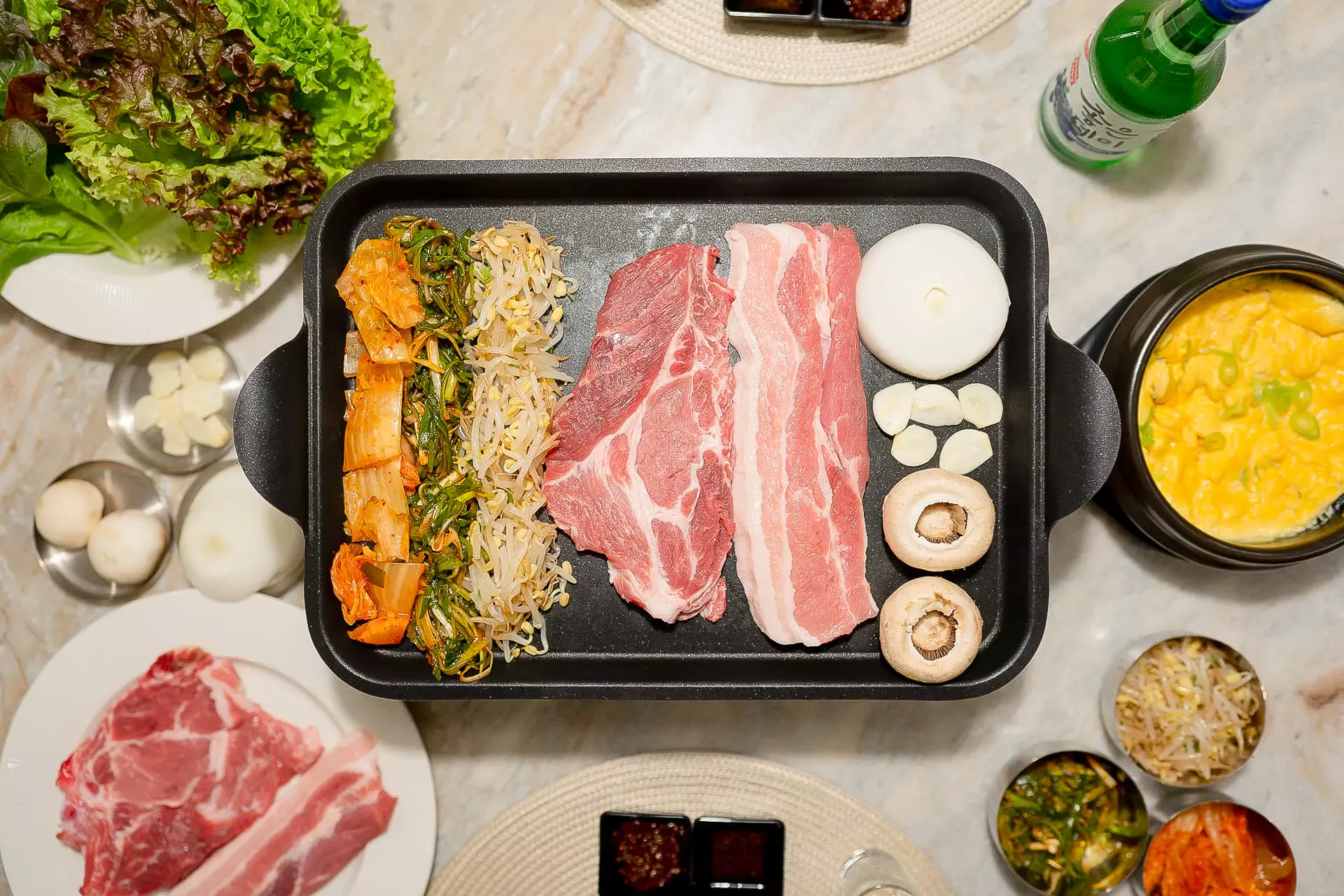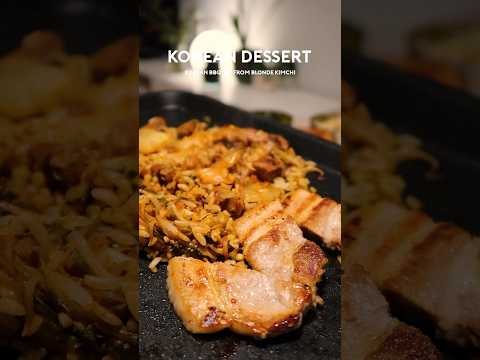Today, I’m sharing the easiest yet most authentic guide to Korean BBQ at home.
The way Korean families enjoy BBQ at home is very different from what you see at restaurants. It’s different in terms of the side dishes and the way the meat is cooked. Even if you don’t live in Korea, I’ll show you the simplest and most delicious way to enjoy Korean BBQ at home.
As a Korean, I want to share the most traditional, home-style version with you.
Table of Contents
What is Korean BBQ?
While “Korean BBQ” literally translates to “Korean-style grilled meat(Gogi Gui),” no one in Korea actually calls it that.
It’s a direct translation that sounds a bit awkward. In Korea, people simply say, “Let’s eat meat,” “Let’s eat samgyeopsal (pork belly),” or “Let’s eat hanwoo (Korean beef).” The name of the meat cut is used, and it’s naturally understood that this refers to Korean BBQ-style grilling.
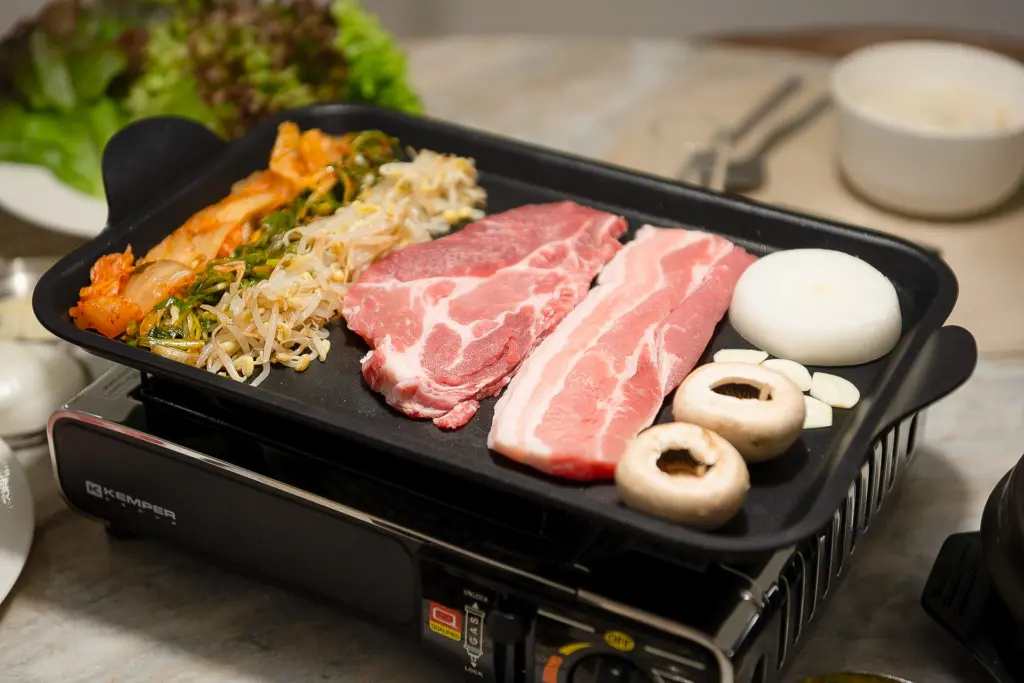
Korean BBQ is typically enjoyed around a grill set in the middle of the table. Everyone gathers around, grilling the meat themselves while eating. It’s served with various side dishes, dipping sauces, and vegetables to wrap (Ssam) the meat in. All of these are meant to be enjoyed with rice.
The most common types of meat used in Korean BBQ are pork belly (samgyeopsal) and pork shoulder (moksal), as well as various cuts of premium Korean beef (hanwoo).
We’ll talk more about the different types of meat, side dishes, and more in the sections below.
What Makes Korean BBQ Unique?
Grilling at the Table
The most distinctive feature of Korean BBQ is that the meat is grilled directly at the table. Typically, one person takes charge of grilling using tongs and scissors.
At home, parents often grill the meat. Among friends, the person best at grilling usually steps in—because Koreans can’t stand poorly grilled, dry meat!
In workplace gatherings, however, it’s usually the youngest or lowest-ranking person who ends up grilling.
Cutting Meat with Scissors
Instead of pre-slicing meat with a knife, Koreans cut it with scissors while grilling. This is both practical and a fun part of the experience.

Charcoal vs Gas
In restaurants, Korean BBQ is often grilled over charcoal, which gives the meat a delicious smoky aroma known as bulmat (“fire flavor”).
At home, most people use a portable gas burner or the kitchen stove instead of charcoal.
Variety of Side Dishes (Banchan)
A key part of Korean BBQ is the variety of side dishes (banchan) served alongside the meat. While the grilled meat is the main highlight, Koreans always eat it with rice and multiple banchan to create a balanced and flavorful meal.
Fresh lettuce or perilla leaves (called ssam vegetables) are served so you can wrap the meat with rice, sauce, and sides.
What makes Korean BBQ unique is that even side dishes are often part of the cooking experience—some banchan, like seasoned bean sprouts or kimchi, are placed on the grill to get crispy or slightly charred, adding another layer of texture and flavor.
In restaurants, you’ll often find a wide selection of side dishes, but at home, people tend to keep it simple and fuss-free. I’ll show you how to do it the easy Korean BBQ at home in this guide today.
Dipping Sauces & Toppings
There are several dipping sauces like ssamjang (a savory soybean paste), gochujang (Korean chili paste), and sesame oil with salt and pepper. Some side dishes, like bean sprout salad, can even be grilled directly on the pan.
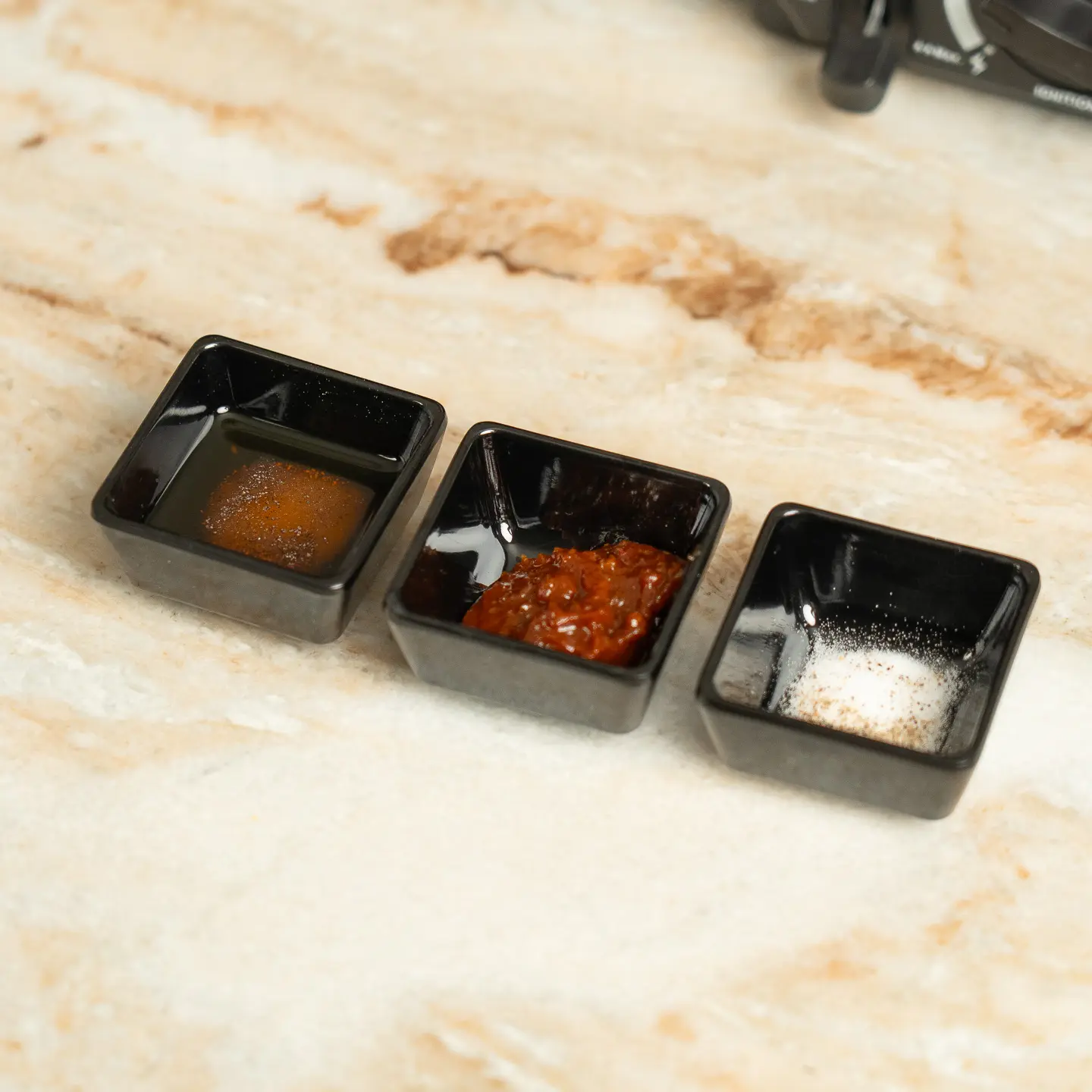
The Harmony
What truly makes Korean BBQ special is this harmony of flavors—meat, vegetables, sauces, and banchan—all coming together at the table. While restaurants serve a wide variety of side dishes, Korean families tend to keep it simpler when eating Korean BBQ at home. We’ll go over that in more detail later.
Why is Korean BBQ So Good?
“Why is Korean BBQ so tender?” Have you ever asked yourself this question? There are actually several reasons.
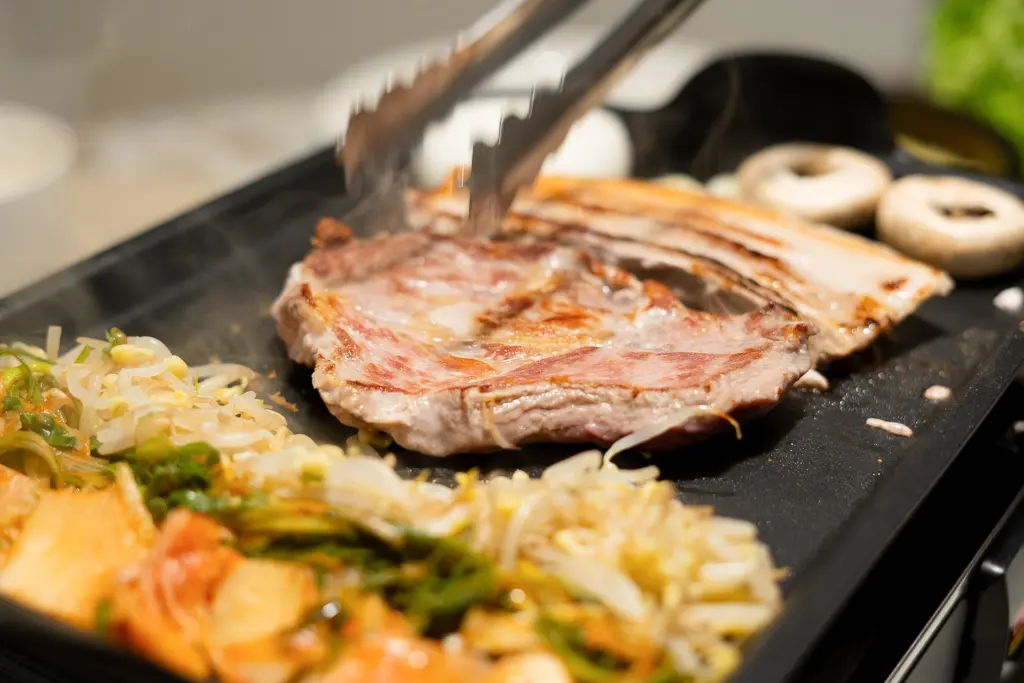
- Fatty Cuts of Meat
Koreans prefer tender cuts of meat when it comes to Korean BBQ. And for meat to be tender, it needs a good amount of fat. That’s why cuts like pork belly (samgyeopsal) or beef chuck flap tail (salchisal) are so popular—similar to wagyu, these cuts are well-marbled. In Korea, samgyeopsal is expensive for this reason, whereas in Europe, fatty cuts are often considered unhealthy and sold cheaply. But recently, studies have highlighted the health benefits of pork fat, so I strongly recommend trying samgyeopsal when you have Korean BBQ.
- Thinly Sliced Meat
Meat is usually sliced thin—around 1cm thick. Even if you grill a whole chunk of pork belly, it eventually gets cut into thin strips with scissors as it cooks. The same goes for Korean beef—it’s typically sliced thin before hitting the grill. Thick cuts are harder to chew and just not as enjoyable.
- Grilling Skills Matter
Koreans really care about keeping the meat juicy. It’s all about grilling the meat in a way that locks in the juices. There’s a real technique to it, and I’ll explain more about that in the how-to-cook section below.
Ingredients & Meat for Korean BBQ
Let’s first take a look at how Korean BBQ is typically served at restaurants.
Then, we’ll explore an easy way to enjoy Korean BBQ at home and compare the two experiences.
Korean BBQ Meat
When it comes to Korean BBQ, the most commonly used meats are pork and beef.
For pork, Koreans’ top choice is samgyeopsal (pork belly), known for its rich fat and juicy texture. Other popular cuts include mok-sal (pork shoulder), hangjeong-sal (pork jowl), galmaegi-sal (skirt meat), and pork rib meat.
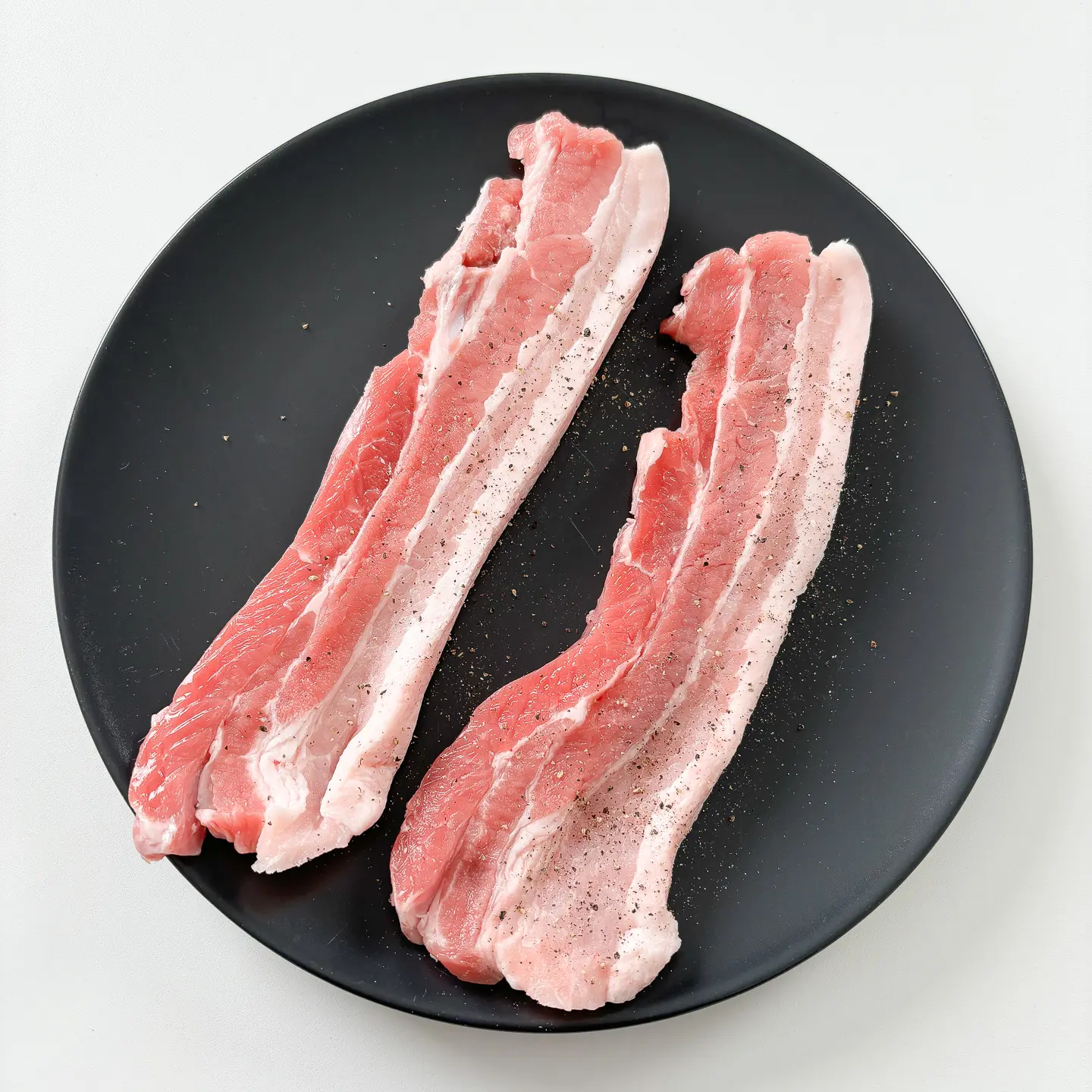
Except for mok-sal, most cuts are quite fatty and tender — which is exactly what Koreans love. As a Korean living in Europe, I’m always happy to see how cheap fatty pork cuts like pork belly are here, since they’re usually pricey in Korea.
For beef, well-marbled cuts are the go-to. These include chuck flap tail (salchisal), ribeye (kkotdeungsim), striploin (chaekkeutsal), and tenderloin (ansim) — all prized for their flavor, tenderness, and juicy texture.
Since these specific cuts are harder to find in Europe, I recommend looking for meat labeled “Wagyu,” or asking your local butcher directly.
Both fresh (unseasoned) and marinated meats are used in Korean BBQ. For marinated options, the most common are soy sauce-based yangnyeom dweji galbi (marinated pork ribs) and yangnyeom sogalbi (marinated beef ribs).
Main Ingredients in Korean Barbecue
- Meat
As mentioned above, pork and beef are the most important meats at Korean BBQ. You can grill them plain or marinated, depending on what you like.
- Vegetables
The most common wrapping veggies (ssam) are lettuce and perilla leaves. Sometimes you’ll also get veggie sticks like cucumber, chili pepper, or carrot — great for dipping in ssamjang or gochujang to refresh your palate between bites.
Other vegetables like onion, garlic, and mushrooms often come as well. These can be eaten raw or grilled on the same pan as the meat. Grilling them brings out their natural sweetness and makes them taste amazing when wrapped with meat and rice.
- Side dishes (Banchan)
Staple banchan include seasoned bean sprouts (kongnamul muchim), kimchi, and green onion salad (pa muchim). You may also get pickled radish slices, white kimchi, or steamed egg (gyeran jjim) — a soft and savory dish that pairs perfectly with grilled meat. In some restaurants, steamed egg is complimentary; in others, you’ll need to order it separately.
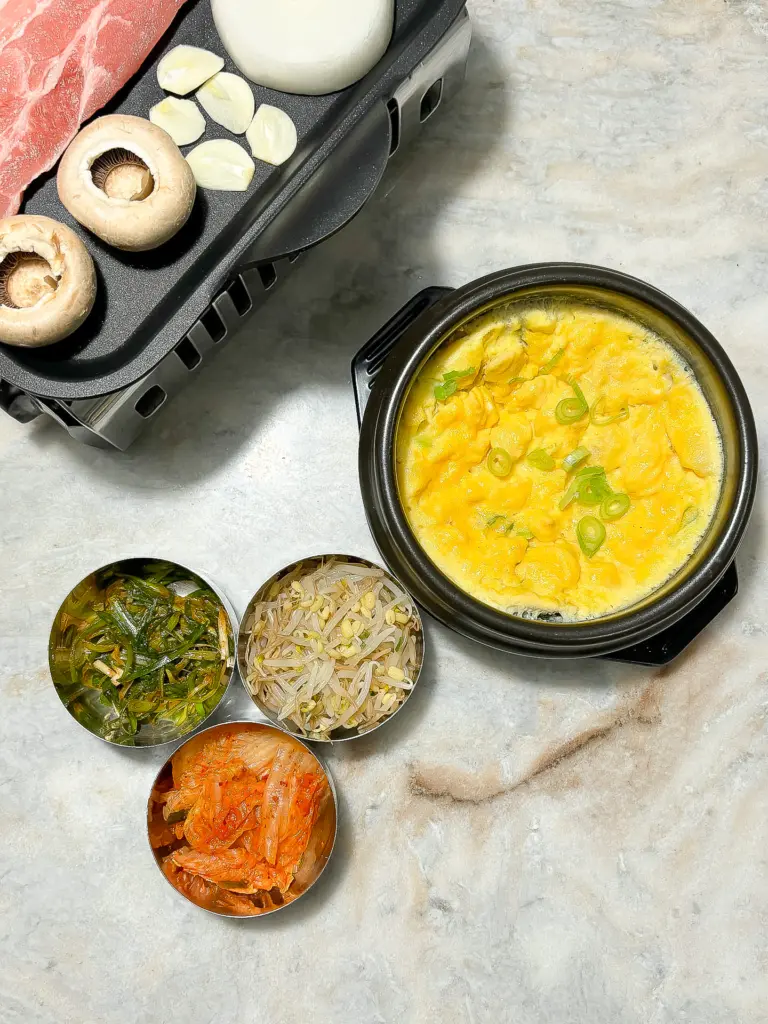
- Dipping sauces
- Ssamjang (soybean paste + chili paste mix)
- Recommended: https://amzn.to/4koIX8c (US), https://amzn.to/43EJdKz (DE), https://amzn.to/3Dkfn2Z (NL), https://amzn.to/43OniAt (UK)
- Sesame oil sauce (with salt and pepper)
- Recommended: https://amzn.to/3QCZIyE (US), https://amzn.to/4lrtaWE (UK), https://amzn.to/43fg5cn (DE), https://amzn.to/4bdP8Ys (NL)
- Salt dip
- Gochujang
- Recommended: https://amzn.to/3XstNFi (US), https://amzn.to/4hSoh65 (DE), https://amzn.to/4l4b2BU (NL, BE), https://amzn.to/4curibS (UK)
- Ssamjang (soybean paste + chili paste mix)
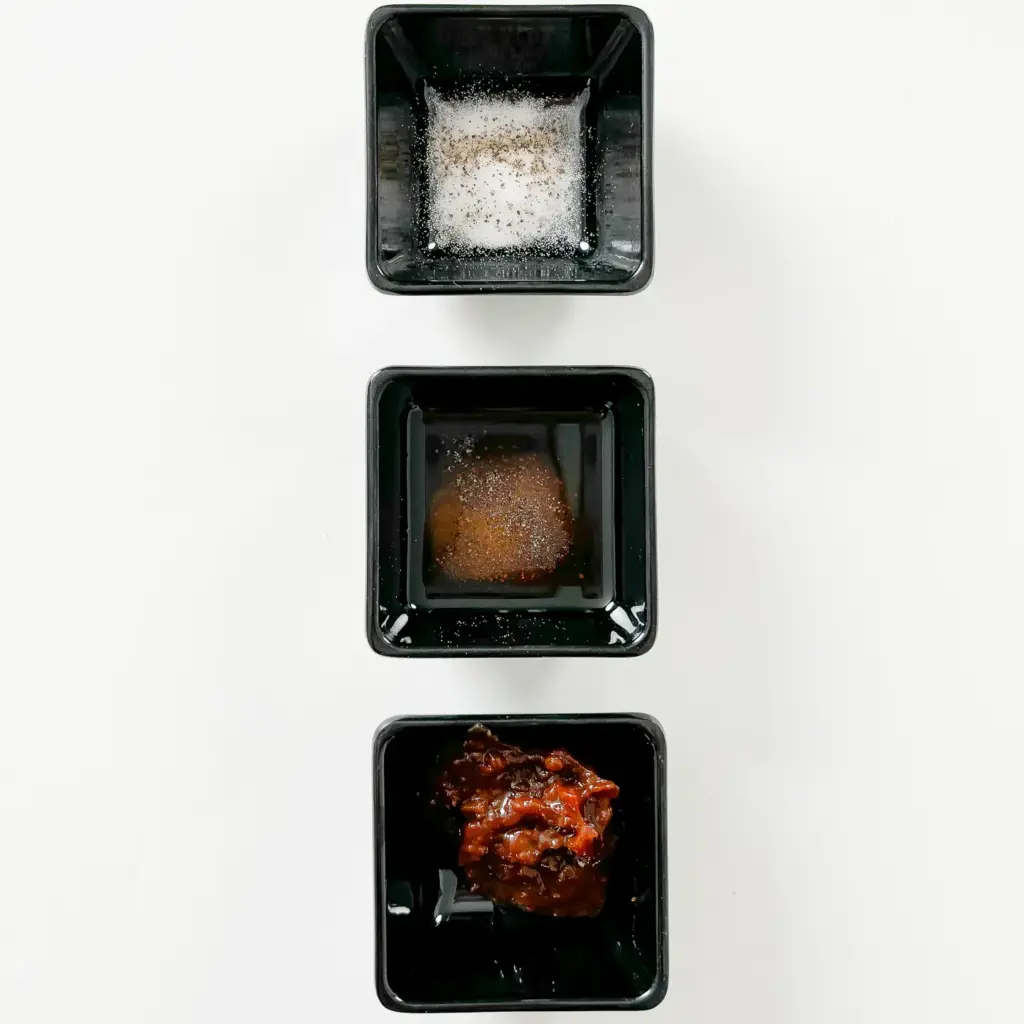
- Extras
Many Koreans enjoy eating BBQ with a bowl of doenjang jjigae (soybean paste stew) and rice. Some also love finishing the meal with a refreshing bowl of cold noodles (naengmyeon) — the salty-sweet, tangy taste goes well with grilled meat.
Is Korean BBQ Sweet or Spicy?
For Koreans, plain grilled meat is the standard when it comes to BBQ. Marinated options, like yangnyeom galbi (beef or pork ribs), are also common.
These marinades are usually soy sauce-based and slightly sweet. However, spicy versions do exist, such as gochujang samgyeopsal (spicy pork belly), which uses Korean chili paste for a kick.
Cooking Korean BBQ at Home Guide
Can you do BBQ at home? Yes!
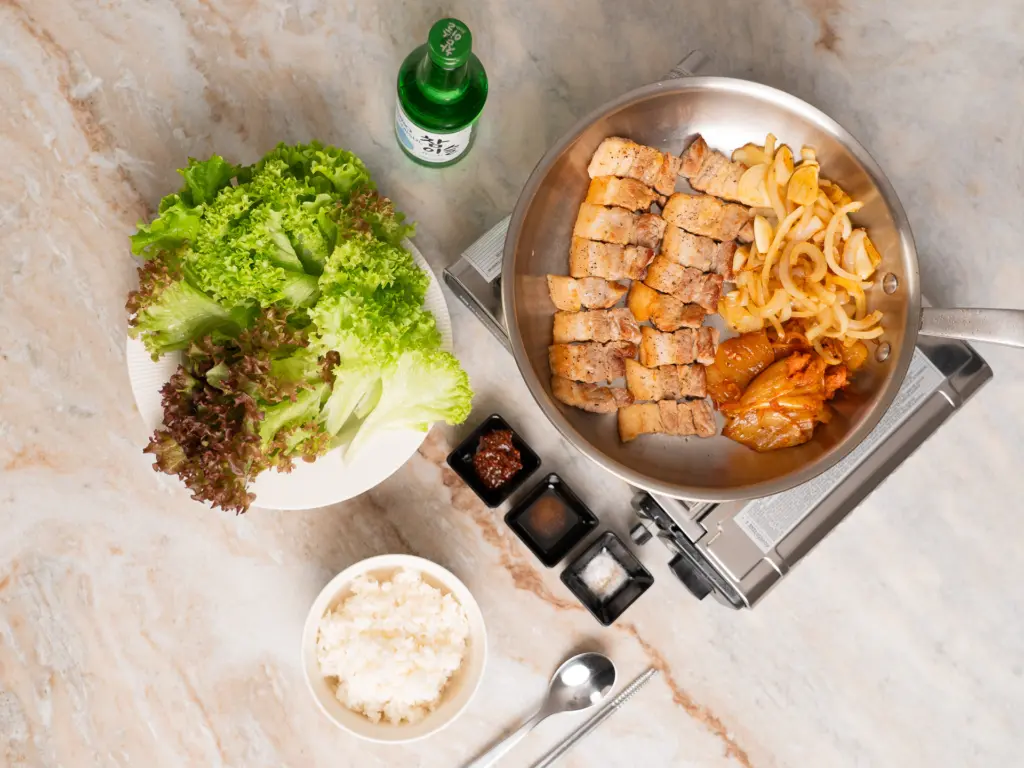
While cooking Korean BBQ at home is possible, it is definitely different from what you’d experience in a restaurant. At home, you can simplify the process and still enjoy a delicious meal.
Many people think it requires a lot of preparation, but for Koreans, it’s often the go-to “lazy dinner” when you want something tasty and quick. It can be done in just 15-20 minutes! This makes it a perfect choice for days when cooking feels like a hassle, yet you still crave something flavorful.
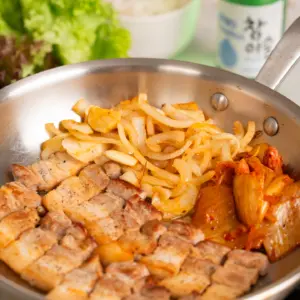
The easiest and most simple version of Korean BBQ at home is the recipe shared in the previous post. This version is the most homey and straightforward way to enjoy — truly the simplest, most authentic recipe for the best Korean BBQ at home.
Meat
The most commonly used meat for Korean BBQ at home is pork belly (samgyeopsal). It’s cheaper than beef, and Koreans prefer the tender, fatty cuts of meat. Other popular cuts of pork include pork neck (moksal), which is leaner, and pork jowl (hangjeongsal), which has a great balance of fat and a nice texture when chewed. The thickness of the meat varies depending on the cut, but for pork belly, the most preferred thickness is around 1-2 cm.

Beef is more expensive, so it’s not as commonly used for home Korean BBQ. However, the most beloved cut for Korean BBQ is undoubtedly Hanwoo beef (hanwoo). Koreans love cuts with good marbling — a perfect balance of fat and lean meat — and the most popular cuts are short ribs (galbissal), sirloin (kkotdeongsim), chuck flap (salchisal), and flank steak (buchesal). Brisket (chadolbagi) is also a favorite, as it has a good amount of fat and a great texture.
Vegetables
Vegetables in stick form, like carrot, cucumber, and chili pepper, are common side dishes for Korean BBQ. But for a simple BBQ, you don’t necessarily need vegetables like carrots or cucumbers. If you’re cooking for the whole family, you may add these vegetables, but for a quick meal for one or two people, garlic and onions are enough to create a delicious meal. These can be eaten raw, but grilling them on the BBQ plate enhances their flavor. The oil from the meat coats the onions and garlic, bringing out their sweetness and making them the perfect side dish to wrap with the meat.
As for ssam vegetables (ssamchaeso), many Koreans skip them when eating BBQ alone at home. Washing and preparing the leaves can be a hassle, and there’s no strict rule that you have to eat the BBQ in a wrap. If you do decide to make ssam, lettuce (sangchu) is usually enough to serve as the wrap.
Side Dishes
This is probably one of the biggest differences. In restaurants, there are usually more than three different side dishes served. Especially in Europe and the U.S., there’s often a very large variety of side dishes when you order Korean BBQ. This is a common conception that foreigners have — thinking that Korean food always comes with a lot of side dishes.
The most representative side dishes for Korean BBQ are kimchi, kongnamul muchim (seasoned bean sprouts), and pa jeolgi (seasoned green onions). These three dishes are typically spicy, served either raw or grilled. They go perfectly when you add them to your ssam (lettuce wraps) along with the grilled meat.

Other side dishes commonly found in Korean BBQ restaurants include ssam mu (pickled radish slices) for wrapping the meat, baek kimchi (white kimchi), and yangpa jangajji (pickled onions) to refresh your palate from the richness of the meat. Oh, I almost forgot! Many Koreans also love to eat myeong-i namul (seasoned wild chive) with samgyeopsal (pork belly). Its tangy and sweet flavor pairs wonderfully with the rich, fatty meat.
However, when Koreans have Korean BBQ at home, you don’t really need many side dishes other than kimchi. Kimchi is delicious on its own, but especially when grilling meat, it’s the best when cooked with the pork belly fat. The sourness of the kimchi mellows out, and when it meets the meat, the umami and flavor rise to a whole new level. Once you start grilling kimchi, you’ll never have Korean BBQ without grilling it every time.
No kimchi? Not a problem at all. Many single Koreans are too lazy to even take out kimchi, so they just eat rice with the meat. Still, it’s delicious!
Sauces
The most basic sauces are ssamjang, sesame oil with salt and pepper (called sesame oil sauce), and salt with pepper (salt sauce). But when eating at home, just ssamjang is perfect. If you don’t have that, you can simply dip the meat in salt sauce and it’ll still taste great. Many Koreans also enjoy dipping their meat in gochujang (Korean chili paste) instead of ssamjang. For Korean BBQ sauce recipes, refer to the Korean BBQ at Home recipe.
Other Dishes
At restaurants, you’ll often get dishes like steamed eggs and doenjang jjigae (soybean paste stew), but at home, you can skip all those and just focus on the BBQ. After all, we want to eat something quick and delicious!
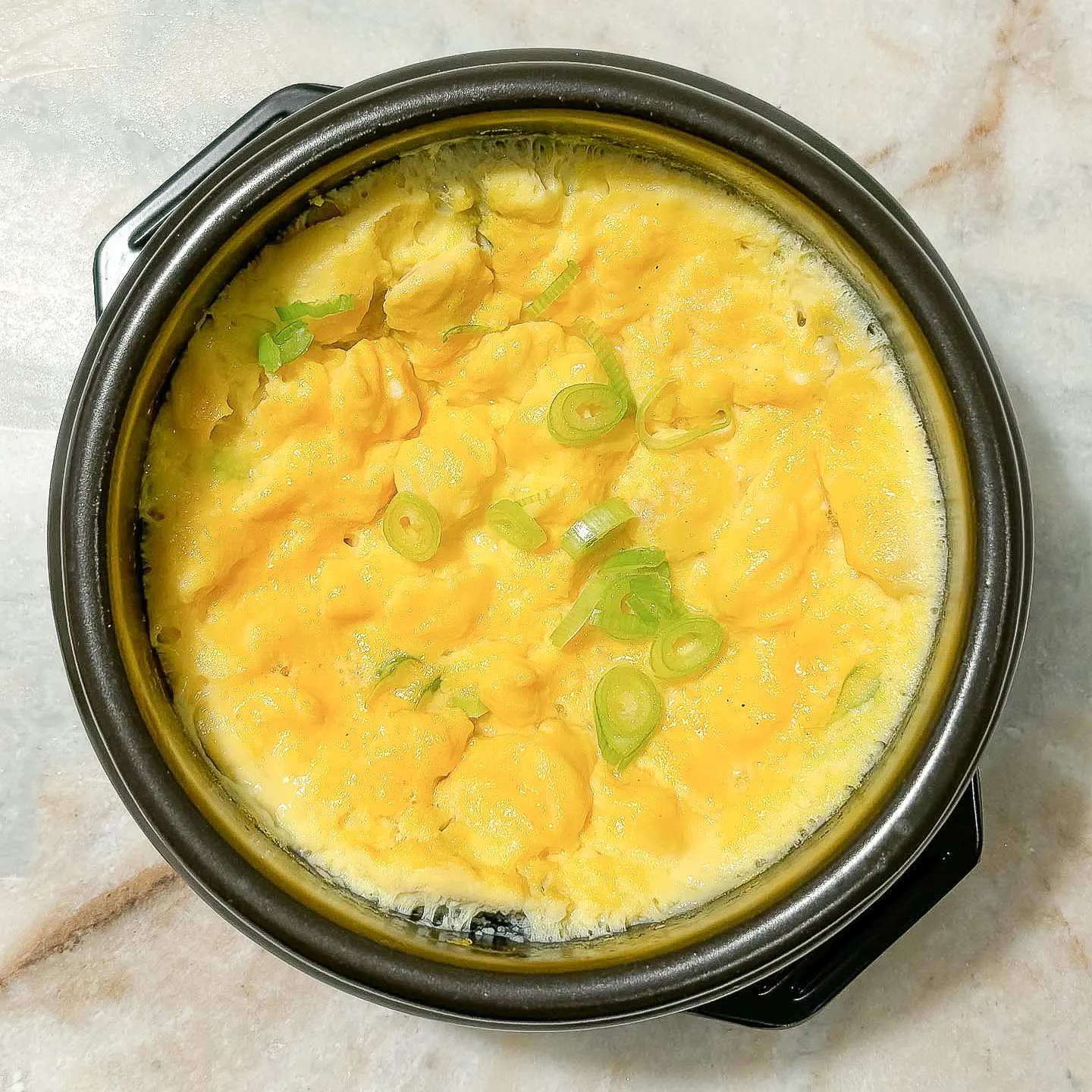
No Grill? Don’t worry!
Many Koreans also don’t have grills at home. Especially for those living alone, it’s quite rare to have a grill. So what do they do? They just use a frying pan. Even if they have a grill, many Koreans simply use a frying pan to make Korean BBQ.
It’s recommended to use a thick stainless steel pan with good heat conductivity. Also, make sure to coat the pan with oil and cook the meat like frying to ensure it cooks evenly. This is a method recommended by many chefs.
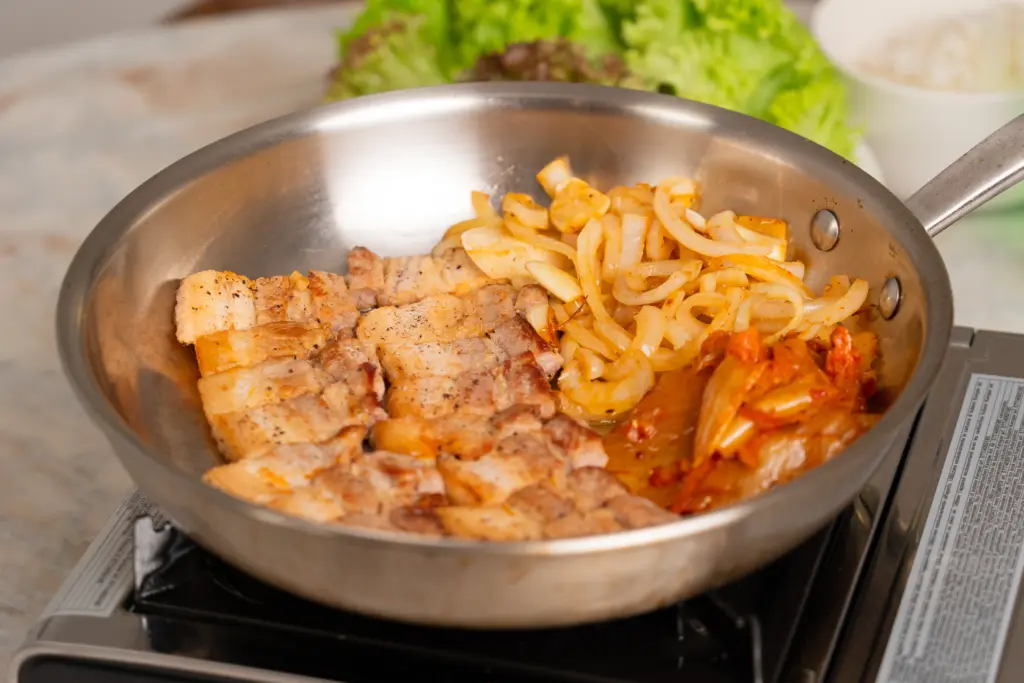
Do You Need to Grill at the Table?
If you have a gas burner, it’s great to grill at the table. However, many Koreans don’t have one. A lot of Koreans simply grill the meat in the kitchen and bring the pan to the table to eat while it’s still hot. There’s no rule that says you have to grill at the table. Wherever you grill it, Korean BBQ will always taste delicious!
Do You Need to Marinate Meat?
In Europe, where I currently live, marinated meat seems to be more popular. However, for Koreans, the basic Korean BBQ is typically fresh, unmarinated meat. You can marinate the meat if you want, but there’s no requirement to do so.
How to Grill Korean BBQ Perfectly
Let’s cook Korean BBQ at home perfectly! take the most common pork belly (samgyeopsal) as an example.
1. Season the Meat
Let’s take the most common pork belly (samgyeopsal) as an example. Before grilling, season the meat with salt and pepper, and let it sit for a while so the flavors deeply penetrate the meat.
2. Add Oil to the Pan
If you’re grilling at home, many chefs recommend adding oil to the pan. It helps the meat cook more evenly.
3. Preheat the Pan
Heat the pan over high heat, add the oil, and place the pork belly in the pan.
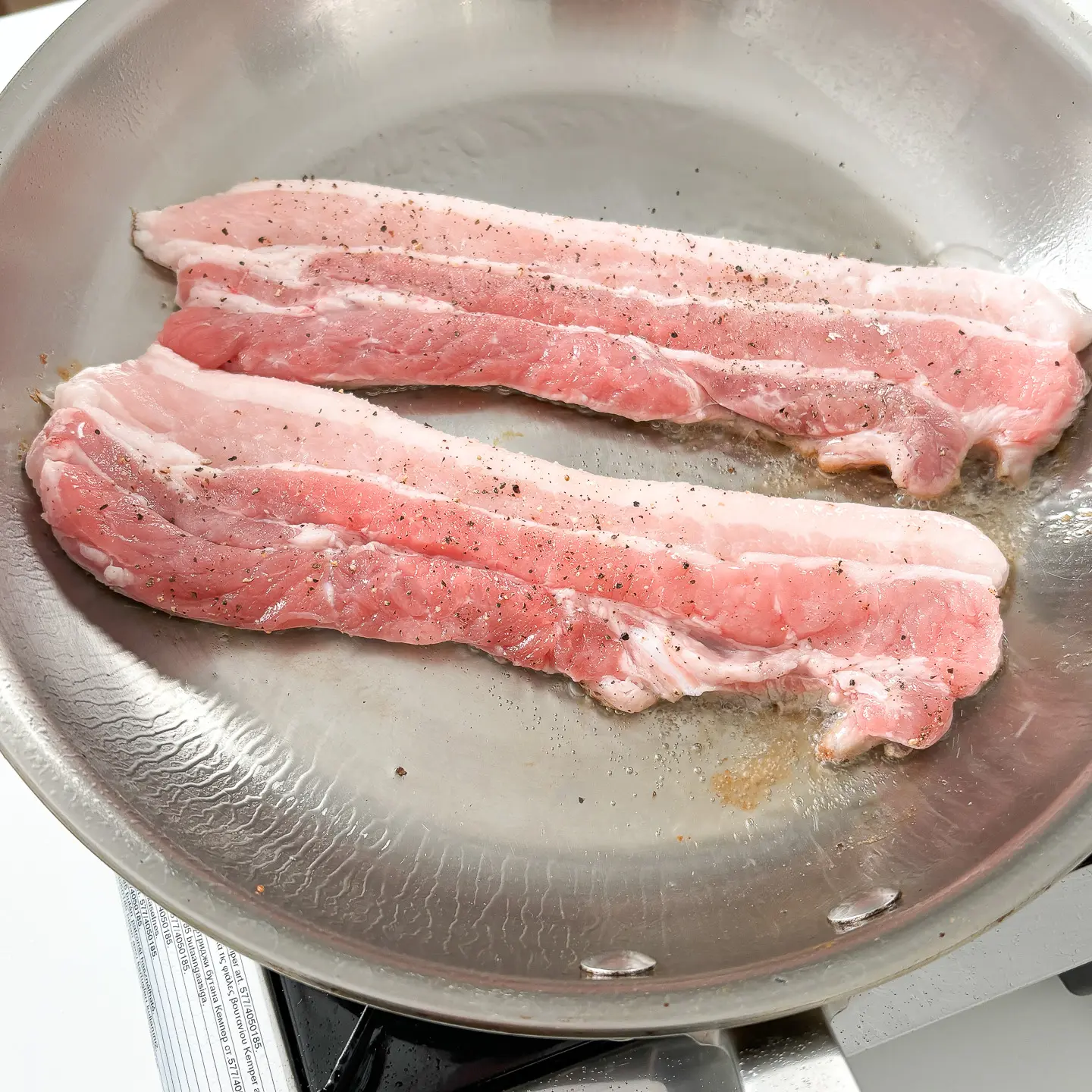
4. Flip Once Golden Brown
When about one-third of the meat is cooked and the bottom is golden brown, flip it over. This will trigger the Maillard reaction, sealing in the juices and creating a crispy surface.
5. Frequent Flipping
From this point on, it’s important to flip the pork belly frequently to prevent it from burning. Many people believe that flipping it just once is enough, but juice tests show that flipping it more often actually helps retain more juices.
6. Cut the Meat
Once the meat is cooked to your liking, cut it into pieces with scissors.
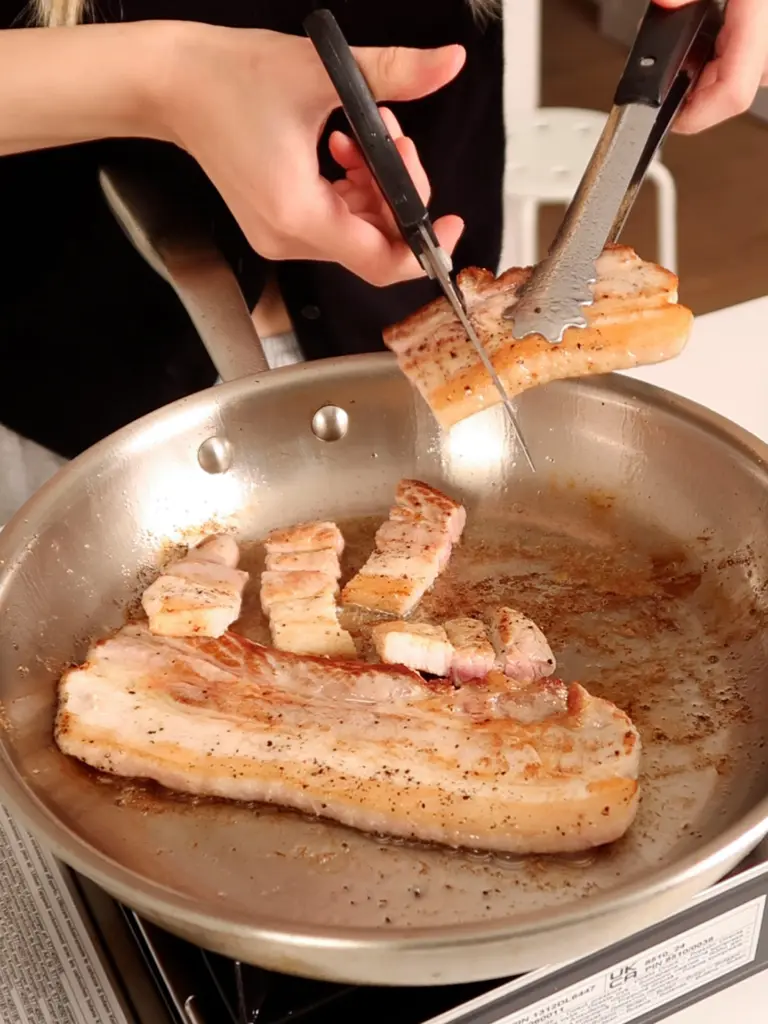
7. Make the Perfect Side Dish
Tilt the pan to gather the oil and use that oil to sauté the kimchi. You can also fry garlic and onions in the pork fat for extra flavor. This is the perfect side dish for your Korean BBQ.
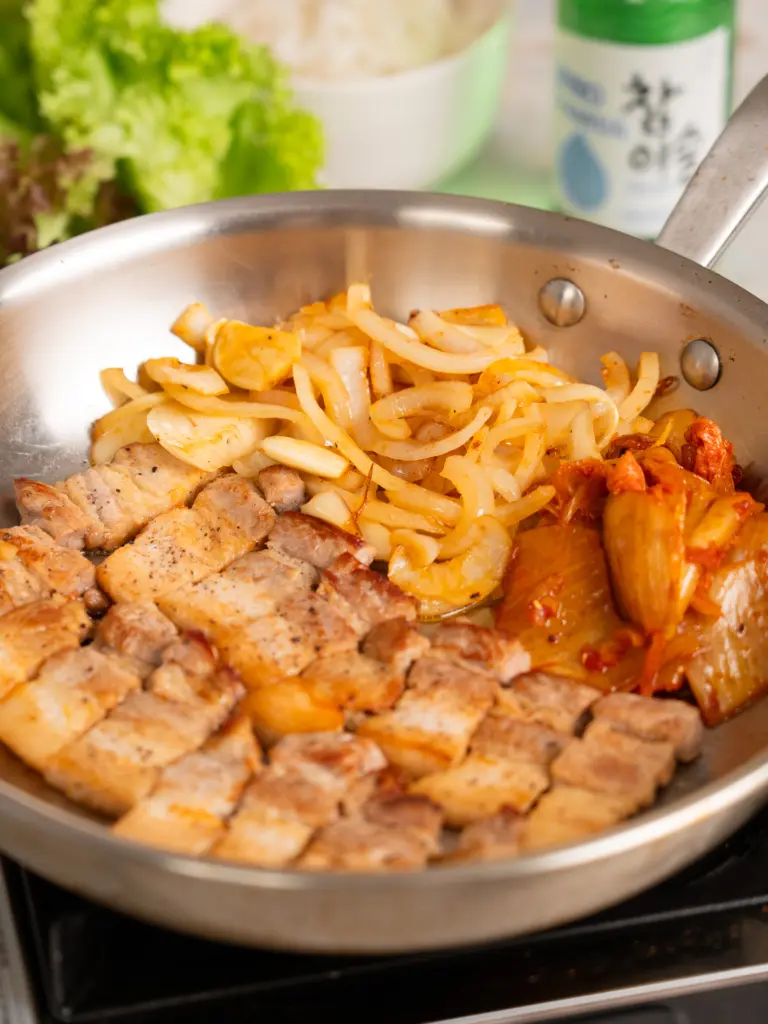
Essential Kitchen Tools for Korean BBQ at Home
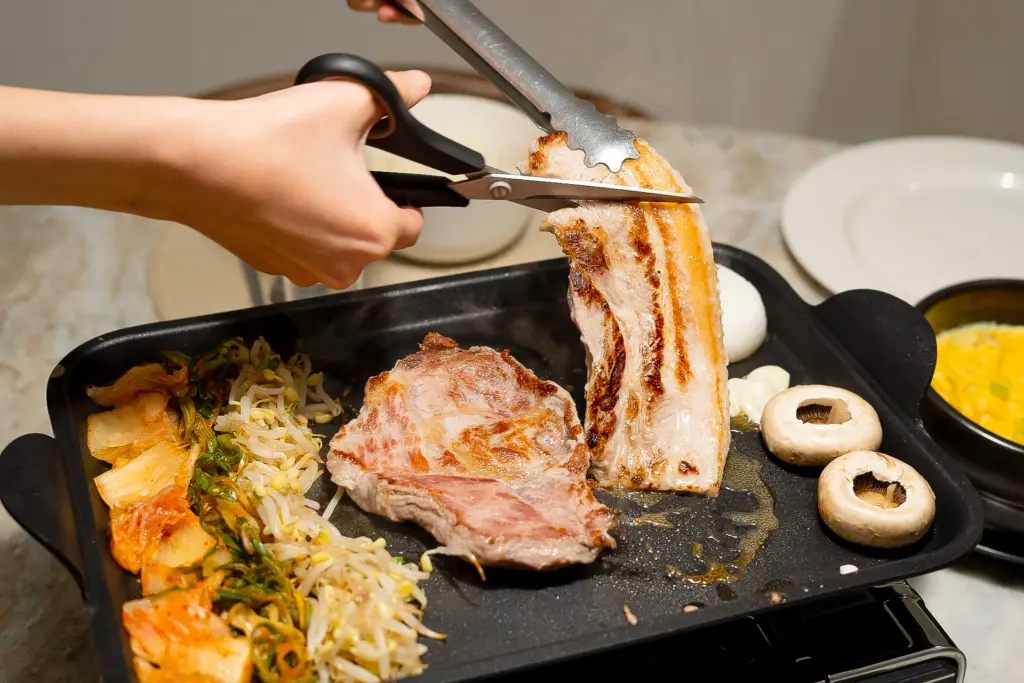
- Grill or Pan
While grilling on a proper grill is ideal, using a pan works perfectly fine as well. Just make sure to use a thick, high-quality stainless steel pan with good heat conduction that doesn’t have a peeling coating.
Grill: https://amzn.to/3EiqVnW (US), https://amzn.to/3XU7kkK (UK), https://amzn.to/4jpRyWP (DE), https://amzn.to/3G2jnWV (NL, BE)
Stainless steel pan: https://amzn.to/42whr0B (US), https://amzn.to/43Pp7NB (UK), https://amzn.to/4cra1Ah (NL, BE), https://amzn.to/4i9NKI8 (DE)
- Tongs
Tongs are an absolute must for Korean BBQ. You’ll need them to flip the meat while grilling. Of course, some people use chopsticks as an alternative, but tongs make the job much easier. Many Koreans even use chopsticks instead of tongs at home.
Recommended: https://amzn.to/4i9O4qk (US), https://amzn.to/428Mbpn (UK), https://amzn.to/43Uiee5 (DE), https://amzn.to/3Ypp8nK (NL, BE)
- Kitchen Scissors
Kitchen scissors are essential for Korean BBQ. You can use them to cut the meat directly on the grill. Once you try using kitchen scissors, you’ll wonder why you didn’t know about them sooner. They’re incredibly handy for cutting almost anything!
Recommended: https://amzn.to/4crbPcw (US), https://amzn.to/43IM4Cd (DE), https://amzn.to/3FS0Ix0 (BE, NL), https://amzn.to/4jvayn6 (UK)
- Small Bowls for Sauces
You’ll need small bowls to serve the sauces for dipping, like ssamjang or soy sauce-based mixtures.
Recommended: https://amzn.to/4j8muLH (US), https://amzn.to/4ifBAhh (UK), https://amzn.to/4immO8w (DE), https://amzn.to/4j7FpWY (BE, NL)
- Side Dish Plates
Recommended: https://amzn.to/4iffLOG (US), https://amzn.to/3R9cPrU (UK), https://amzn.to/4igoyjw (NL, BE), https://amzn.to/44k4JnS (DE)
- Plates or Baskets for Ssam Vegetables
- Earthenware Pot (Ttukbaegi)
If you’re making a stew like doenjang jjigae or steamed eggs (gyeran jjim), a traditional earthenware pot (dukbaegi) is ideal for maintaining the heat and flavor.
Recommended: https://amzn.to/4lgtPKm (US), https://amzn.to/4hWscyH (DE), https://amzn.to/3QYfftl (BE, NL), https://amzn.to/4cwh5vx (UK)
How to Eat Korean BBQ at Home Guide
Here’s the easiest and most authentic “How to Eat Korean BBQ at Home” guide
1. Grill the Meat: Grill the meat on a pan or grill.
2. Grill the Veggies: Grill veggies like onions, garlic, and mushrooms in the meat’s oil.
3. Stir-fry the Kimchi: Stir-fry the kimchi in the meat’s oil to enhance its flavor.
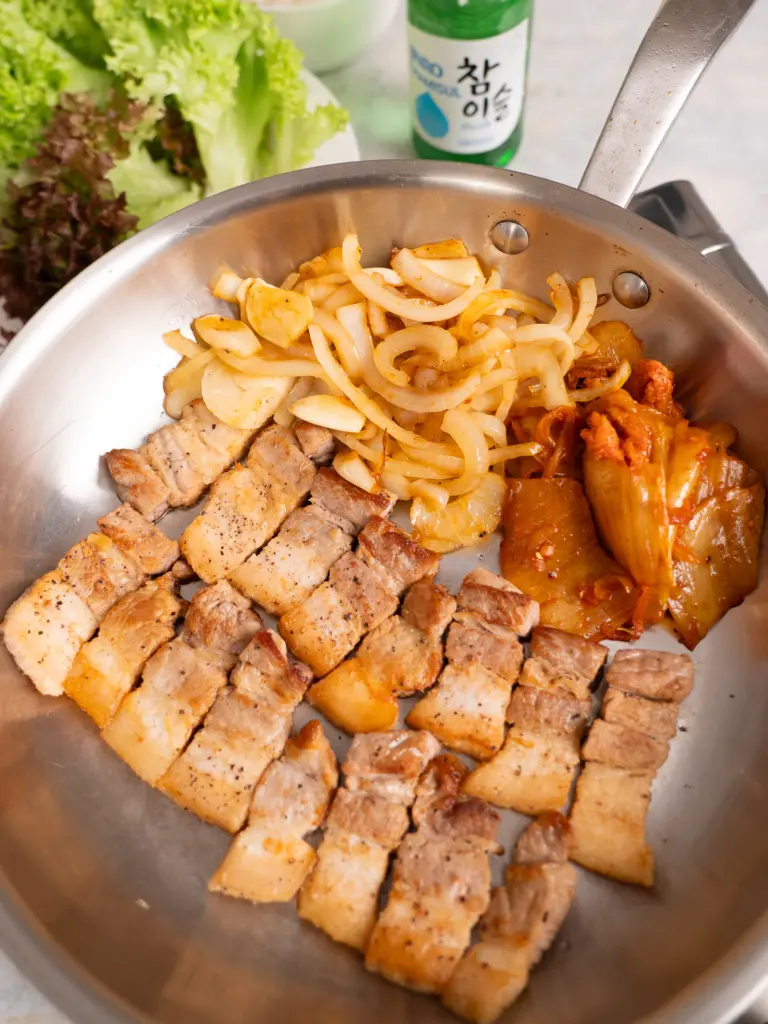
4. Grill the Sides: You can also grill side dishes like bean sprout salad and green onion salad.
5. Dip in Sauce: Dip the meat in Korean BBQ sauces like ssamjang or salt sauce.
6. Make Ssam (Wrap): Place the meat on lettuce or perilla leaves, add the sides and veggies, and wrap it up.
7. Doenjang Jjigae & Steamed Eggs: Doenjang jjigae and steamed eggs are eaten with the BBQ and rice, not as appetizers!
8. Fried Rice with Leftovers: If there’s leftover meat and sides, you can turn it into fried rice.
This is the easiest, most authentic way to enjoy Korean BBQ at home!
How to Wrap Ssam
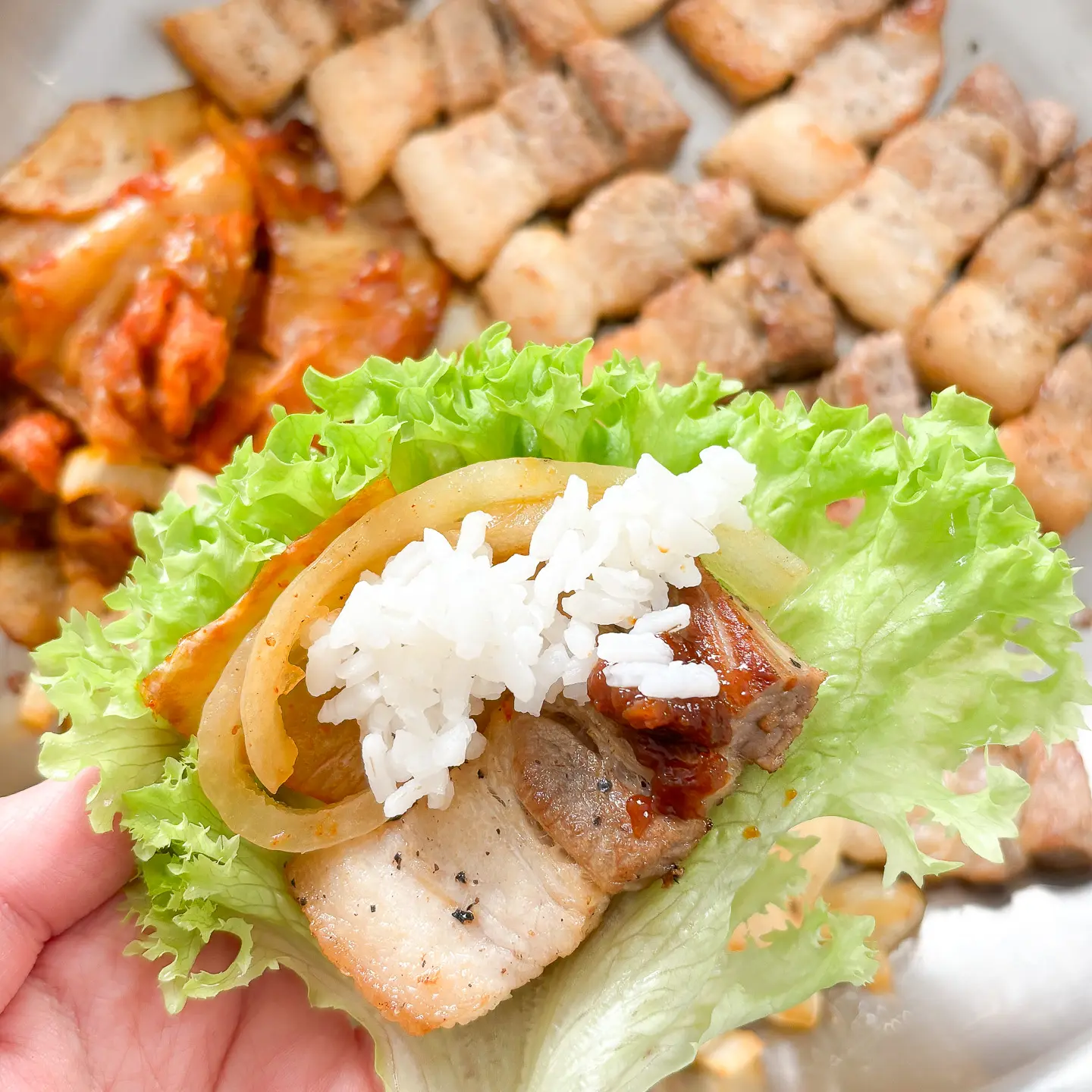
1. Dip the meat in sauce and place it on lettuce or perilla leaves.
2. Add your desired sides on top.
3. You can add rice, but it’s optional.
4. Add grilled onions or garlic for extra flavor.
5. Wrap everything up with the ssam vegetables and eat it in one bite. Ssam is not a taco! Eating it in one bite will make all the flavors blend harmoniously.
Pairing Drinks with Korean BBQ
The drink most loved by Koreans when eating Korean BBQ is soju. It’s clean and has a higher alcohol content than other alcoholic drinks, helping to cut through the richness of the fatty meat. Another popular choice is so-maek, a mix of soju and beer. This combination adds a refreshing fizz, making it smooth to drink while also cutting through the oiliness of the meat.
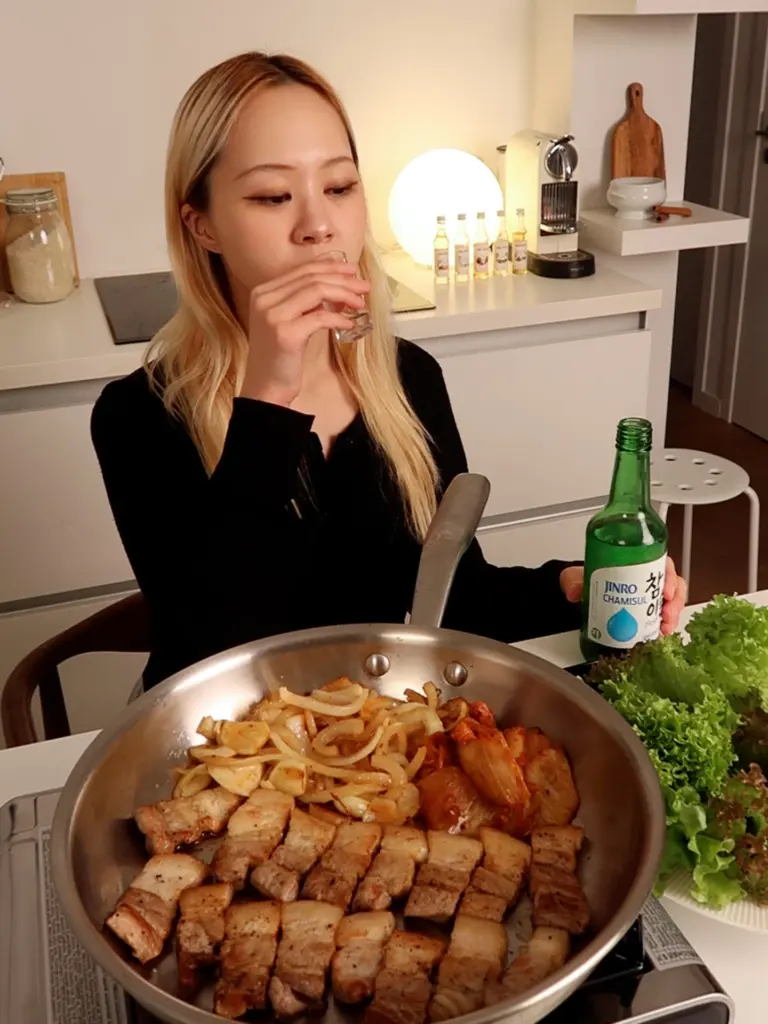
For non-alcoholic options, cola or cider is the best. Their strong carbonation pairs wonderfully with the greasy meat, helping to balance out the richness.
Perfect Pairings with Korean BBQ
Naengmyeon (Cold Noodles)
This is a dish you’ll always see at Korean BBQ restaurants. The combination of the sweet and tangy cold broth with the grilled meat is one of Koreans’ favorite pairings. It’s usually enjoyed as a side dish or dessert, so it’s generally cheaper than what you’d find at a dedicated naengmyeon restaurant. Most Korean BBQ places won’t let you order naengmyeon unless you order meat, so remember this when dining at a Korean BBQ restaurant in Korea.
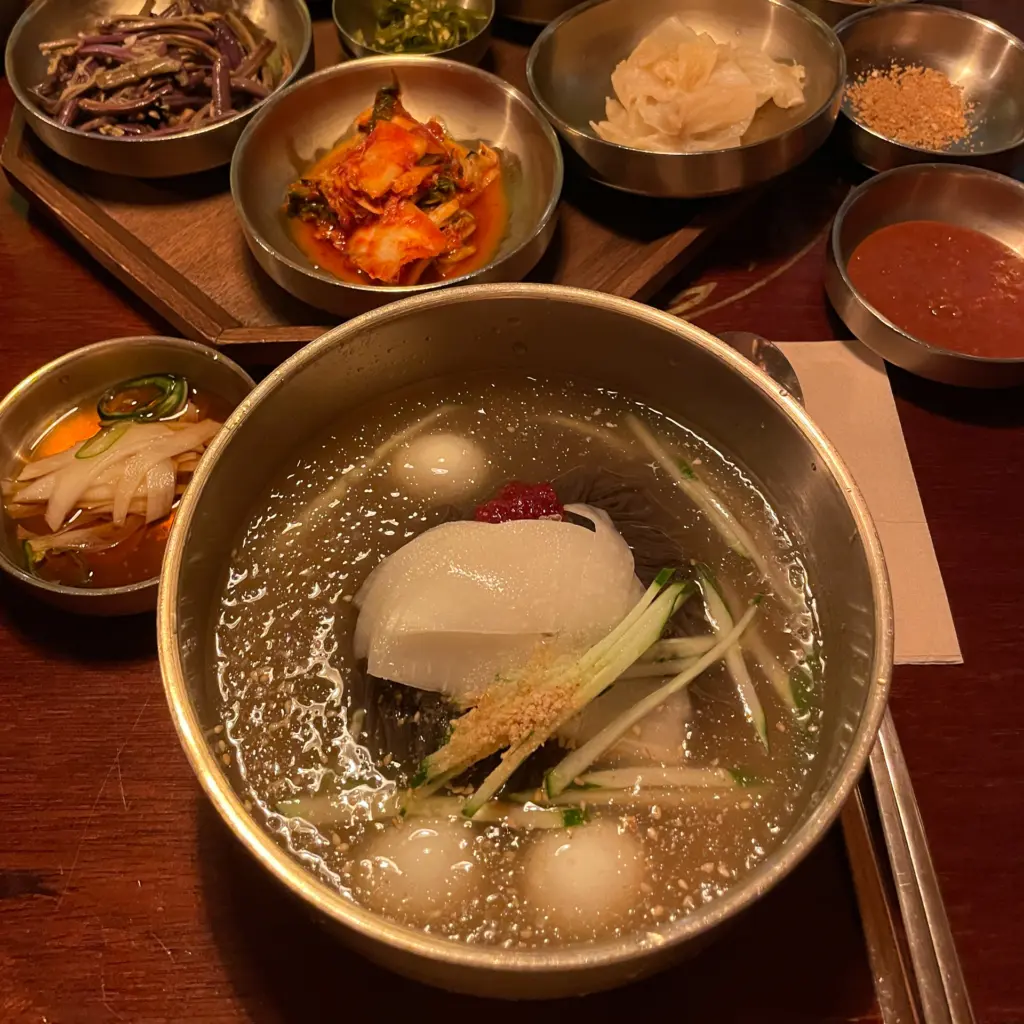
Doenjang Jjigae & Rice (Soybean Paste Stew)
Doenjang jjigae is a staple in any Korean BBQ restaurant. Even when eating it at home, Koreans love to make this stew. Sometimes, the meat is added directly into the stew, and the savory flavor from the meat fat makes the soup even more delicious.
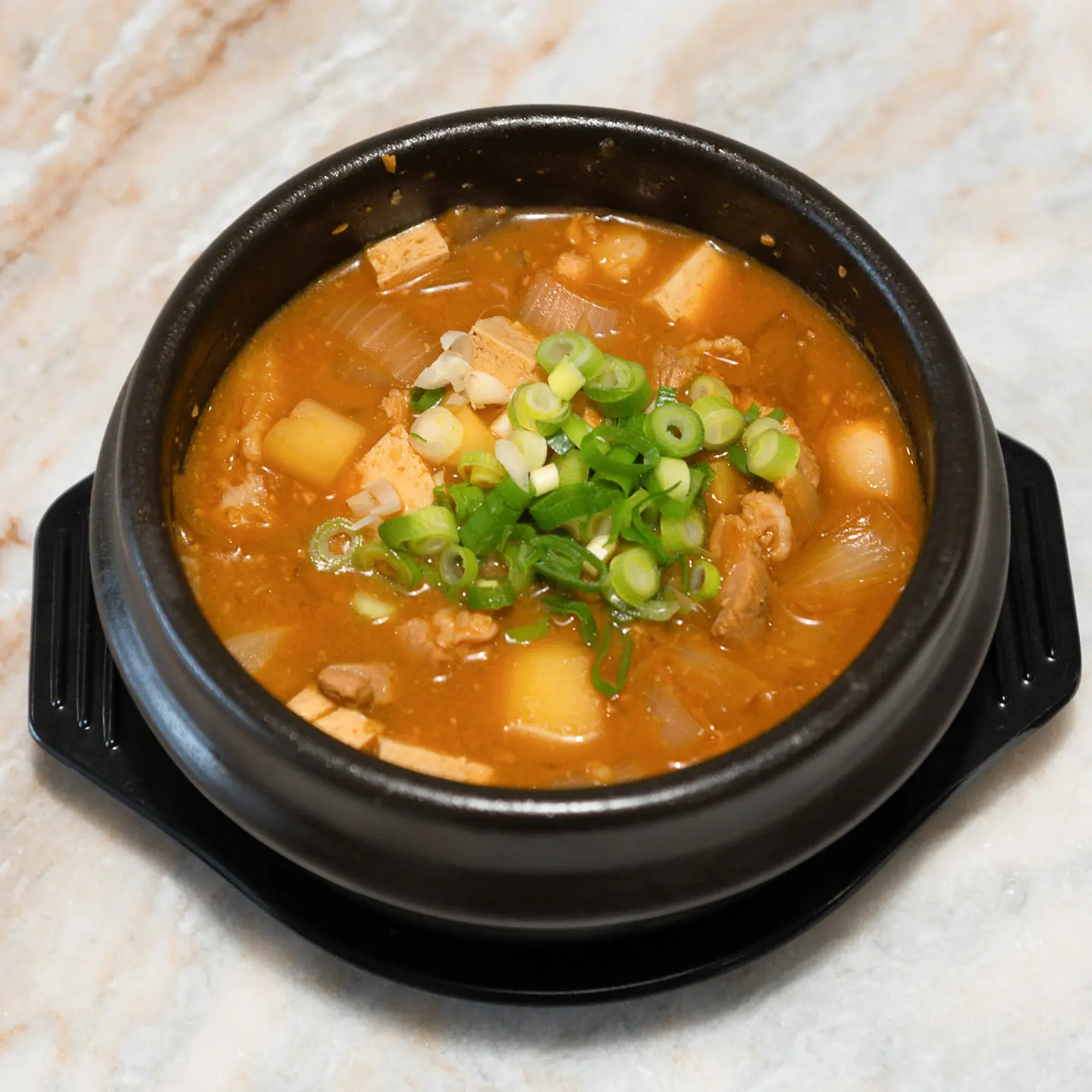
Korean BBQ Fried Rice (K Dessert)
This could be considered a Korean dessert! Many Koreans love to make fried rice after a meal. For example, they’ll make fried rice with leftover broth after eating gamjatang (pork bone soup) or with the remaining meat and side dishes after Korean BBQ.
The recipe for Korean BBQ fried rice is very simple. Just stir-fry leftover meat and kimchi, then add rice and ssamjang (wrap sauce). When the rice and kimchi are fried together in the meat’s oil, it creates a rich and umami flavor. You can sprinkle some seaweed flakes or even add cheese on top for extra flavor. If you have leftover meat at home after eating Korean BBQ, I highly recommend trying this!
